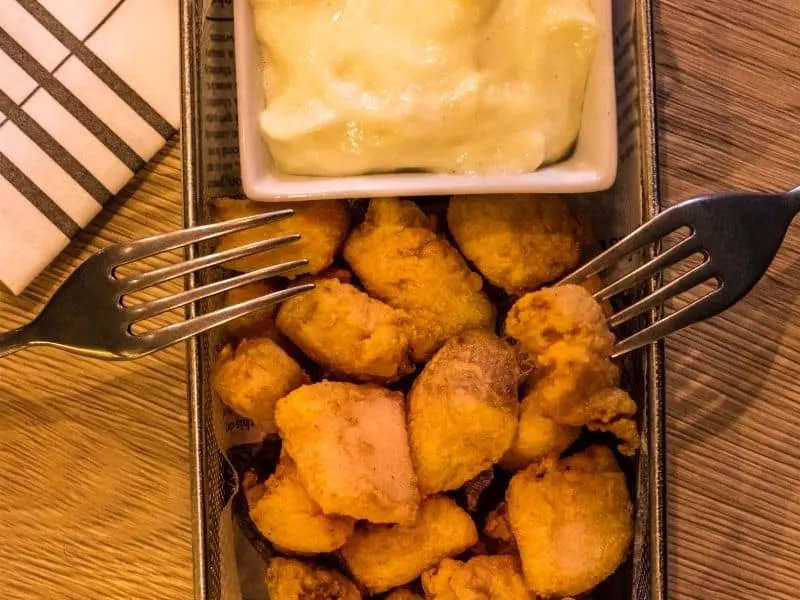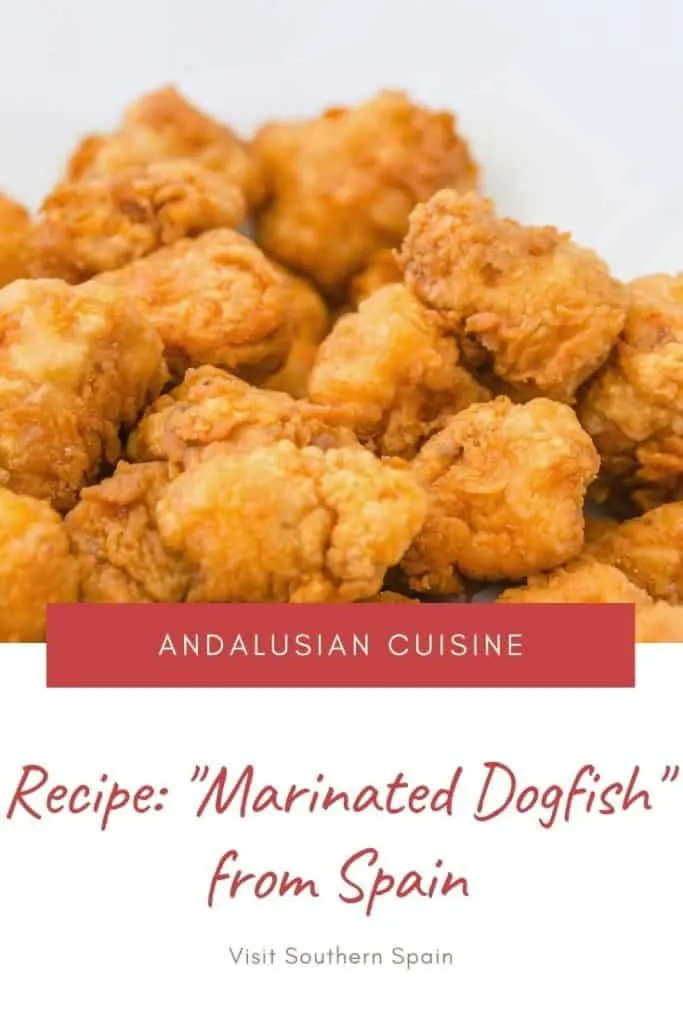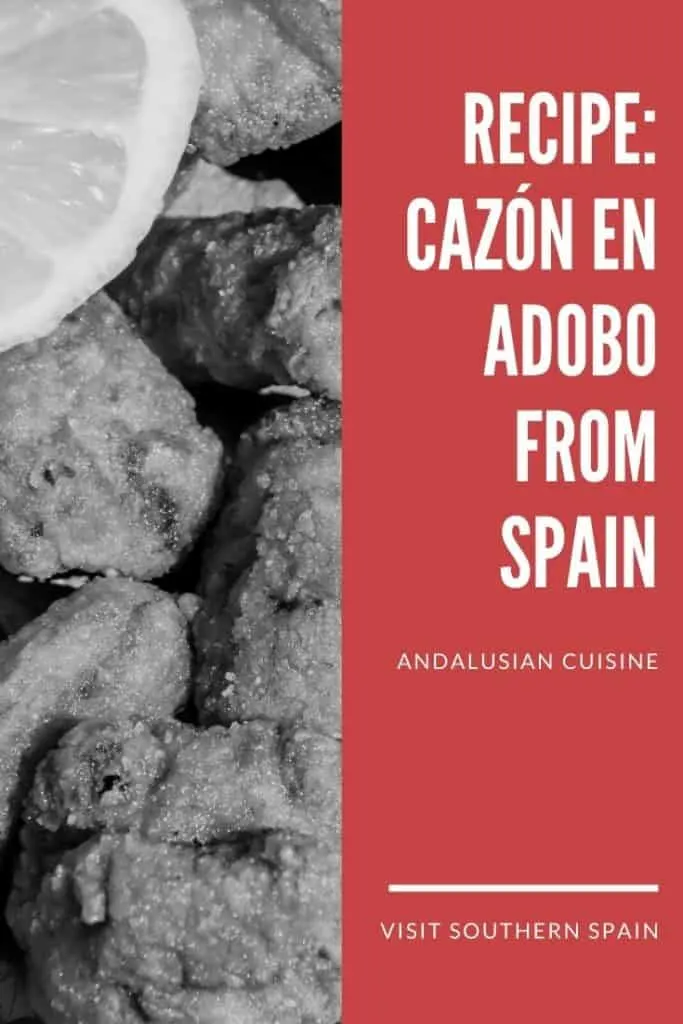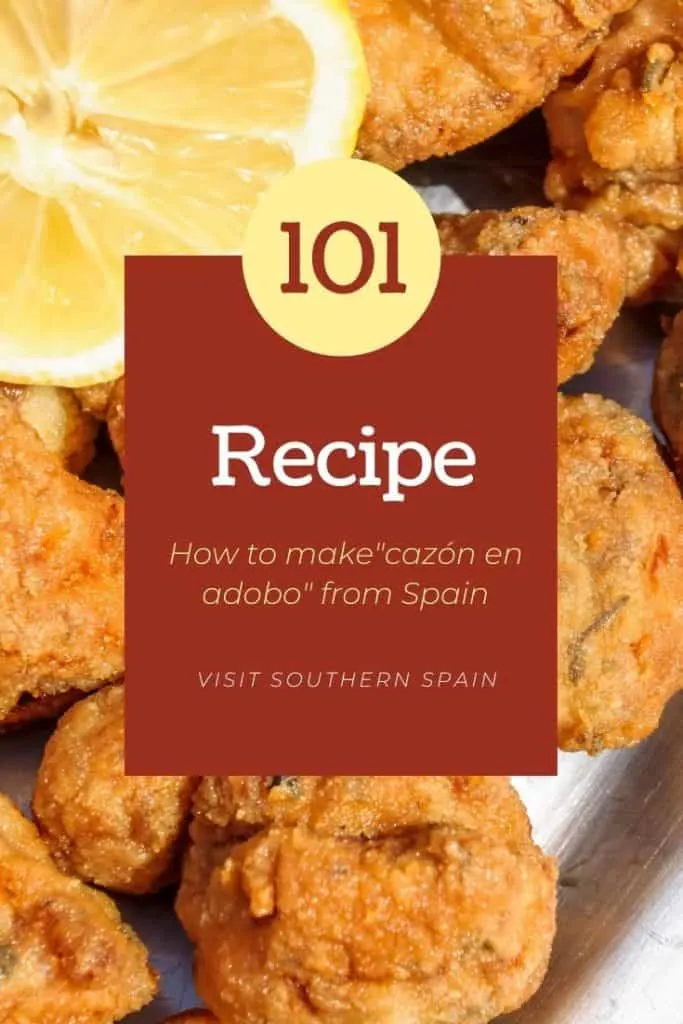The Cazon en Adobo, also known as marinated Cazon fish, is a typical dish from Andalusia and one of the most popular Spanish dishes. The recipe was developed in the 17th century in the city of Cádiz.
Since Andalusia is a region characterized by its beaches and its port activities, it has a rich tradition of cooking with fish.
But the problem in the 17th century was the lack of refrigerators to preserve the fish, therefore this recipe was created.

You, dear reader, support this blog. If you purchase through a link, we earn a small commission. As an Amazon Affiliate, we earn from qualifying purchases.
Background of the Dish

This recipe is made with Cazon because it is a common fish in the area, and since it comes from the Sharks family, it has thick meat that won’t disintegrate while marinating. Cazón is dogfish in English.
The technique used to preserve the fish was covering them in Adobo, which means “dressing” in English and it is a mix of vinegar, water, and spices commonly used to marinate fish.
Eventually, it evolved into the Marinated Cazon fish that we know these days.
If you are ever walking down the streets of Andalusia or looking for what to eat in Malaga or other cities, you might also find this dish with different names, such as Bienmesabe or Pescado en adobo.
Step by Step instructions
To make the Cazon en Adobo you will need the following ingredients:
- 500g Cazon
- 300ml water
- 300ml white vinegar
- 1 teaspoon paprika
- 1 teaspoon dry oregano
- 50g flour
- 1 teaspoon ground cumin
- 2 garlic cloves (minced)
- 20g kosher salt
- 2 bay leaves
- Olive oil

- The first thing you need to do is to cut the Cazon into square pieces, about 1 inch each. While you are doing that, make sure to remove any cartilage or fishbone that you might encounter, even though there shouldn’t be many.
- Take the Cazon pieces into a large bowl and cover it with the spices, salt, garlic, and bay leaves. Also pour enough water and white vinegar to completely cover the fish, this way every single piece will get marinated. After that let the fish marinate for 8 hours or overnight so it soaks the flavor.
- Once that time went by, take the Cazon out of the bowl and remove the excess liquid with a paper towel. Make sure that they are mostly dry, this way there won’t be any liquid in contact with the oil.
- Cover each piece with flour, you can use any type of flour of your choice, but it is recommended to use refined flour (all-purpose, frying or tempura flour, etc.). Meanwhile, start heating the olive oil in a large pot at high heat.
- Fry your Cazon pieces at high heat, even though you can lower them to medium if it seems too hot, and fry them until they get a golden brown color.
- You can flip the pieces to make sure that every part gets the same browning and cooks evenly.
- Each side should take about 2 minutes, but it depends on the oil that you are using and at what temperature, so you can check how long the first one took and do the others the same way.
Substitution of ingredients

There are multiple substitutions that you can make to this dish! For example, you can choose a different type of fish, since the Cazon shark is hard to find outside of Andalusia.
To substitute the Cazon you can try another type of fish that comes from the family of sharks or the rockfish.
To be honest, any type of fish will do the trick, the most important thing is the marinating part.
You can also change things from the marinate, like adding more spicy condiments, or you can also play with different flavors using things like mint instead of bay leaves.
You can even just marinate the fish with salt and pepper (and water and vinegar of course), but the classic and multiple spices really improve the Cazon flavor.
If you love fish and want to try one of the most well-known and easy recipes, we encourage you to try our Spanish sardines pasta, the Spanish fried fish, or the Spanish calamari recipe.
Tips on Serving
The best way to serve this dish is alongside some potato fries and a really cold beer or soda during the hot summer days.
You can also serve it with different types of sauces and dipping creams, for example, sour cream with chopped chives, or just simple mayonesa.
Remember that this is one of the best Andalusian foods to eat, so it shines on its own and you can serve the Marinated Cazon Fish by itself and it will be a delicious entree.
If you want it to be the main course you can serve it on small bowls so everyone gets their own portion.
Tips on Storage of Fried Cazon Fish

This dish can last up to one day in the fridge after it was cooked. If you don’t want to eat them right away, you can freeze them for 15 days up to one month.
Since this is a fish related recipe, the best thing you can do is make it right before eating it, this way the Cazon will preserve its freshness and flavors.
You can also make the marinate a little bit longer if you need more time but you still want to eat fresh fried fish.
For example, you can marinate them for 12 hours, coat them with flour, and let them sit in the fridge for a couple of hours before frying. This way you gain time and you still get to enjoy a fresh and flavorful dish.
If you can’t get enough of marinated cazon fish, have a look at my webstory here.
Recipe Card – Marinated Cazon Fish
Marinated Cazon Fish - Cazon en Adobo Recipe

The Cazon en Adobo, also known as Marinated Cazon fish, is a typical dish from Andalusia and one of the most popular Spanish dishes. The recipe was developed in the 17th century in the city of Cádiz.
Since Andalusia is a region characterized for its beaches and its port activities, it has a rich tradition of cooking with fishes.
But the problem in the 17th century was the lack of refrigerators to preserve the fishes, therefore this recipe was created.
Ingredients
- 500g Cazon
- 300ml water
- 300ml white vinegar
- 1 teaspoon paprika
- 1 teaspoon dry oregano
- 50g flour
- 1 teaspoon ground cumin
- 2 garlic cloves (minced)
- 20g kosher salt
- 2 bay leaves
- Extra virgin olive oil
Instructions
- Cut the Cazon into small square pieces (about 1 inch each)
- Place the Cazon on a large bowl, with salt, garlic, bay leaves, oregano, cumin and paprika.
- After that, cover the Cazon completely with vinegar and water. Cover the bowl with tin foil or the lid of a pot and let it rest for 8 hours or overnight in the fridge.
- Once that they’re ready, remove the excess liquid with a paper towel. Pass the pieces through the flour and start heating the olive oil.
- Once the oil is hot, fry the Cazon until they reach a golden brown color. Serve them hot and enjoy it!
Notes
If you find “frying flour”, that it’s made for this type of dish, use it! You will get a more crunchy texture. Also when it comes to the condiments, you can use any that you like!
Nutrition Information
Yield
5Serving Size
1Amount Per Serving Calories 77Total Fat 3gSaturated Fat 0gTrans Fat 0gUnsaturated Fat 2gCholesterol 0mgSodium 1555mgCarbohydrates 9gFiber 1gSugar 0gProtein 1g
All information presented and written are intended for informational purposes only. You should not rely on this information as a substitute for, nor does it replace, professional medical advice, diagnosis, or treatment. If you have any concerns or questions about your health, you should always consult with a physician or other health-care professional. The writers and publishers of visitsouthernspain.com are not nutritionists or registered dietitians. Statements within this site have not been evaluated or approved by the Food and Drug Administration.



Hola, I’m Paulina! Together with my team, we are passionate about Southern Spain. Here we share all you need to know for great times in Southern Spain with the best places to visit, stay and, of course, the best food to eat.
Let’s dive in and explore Southern Spain’s outdoors, food and culture con pasión!



Gordon
Wednesday 5th of June 2024
Hola Paulina , I am currently in Málaga and today I tried Cazon in a local cafe and have to say I found it delicious. I have to admit I was slightly sceptical at first as I once had dogfish in UK and thought it was disgusting. I have saved your recipe and will try it out. Muchas gracias
Paulina
Monday 17th of June 2024
Hi,
I'm so glad to hear you're in Málaga and enjoyed the cazón! I understand your initial skepticism; past experiences can definitely shape our expectations. But I'm delighted you found it delicious this time.
I hope my recipe helps you recreate the dish and that you enjoy it as much as I do. Please let me know how it turns out when you try it.
Thank you for your message and happy cooking!
Best regards, Paulina